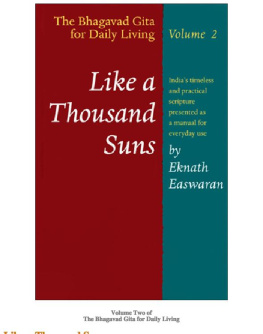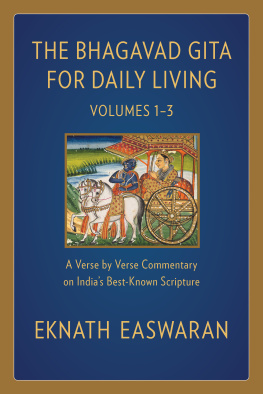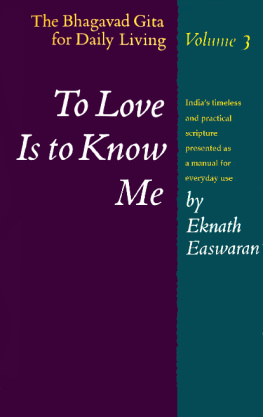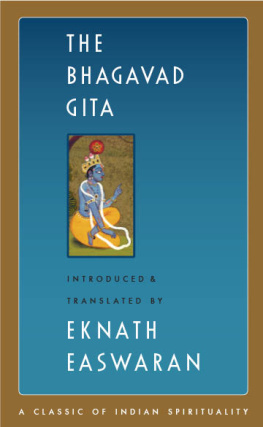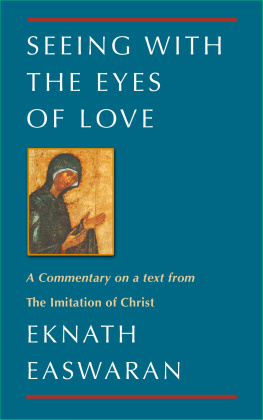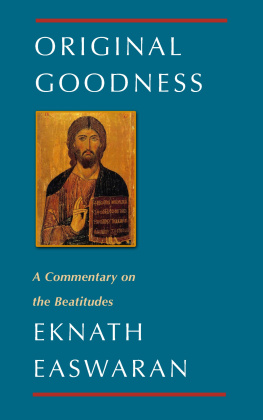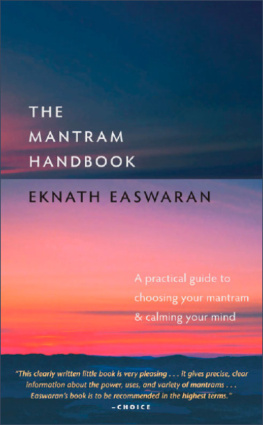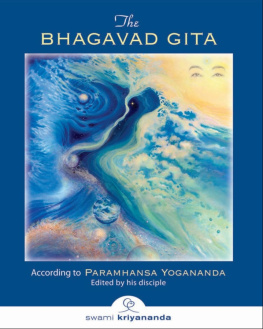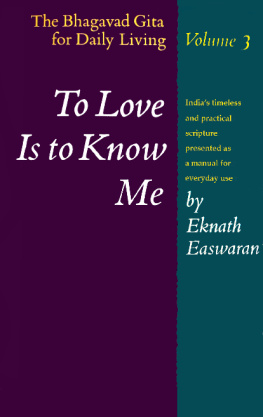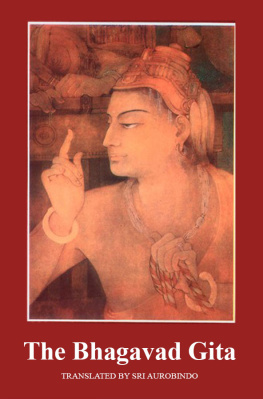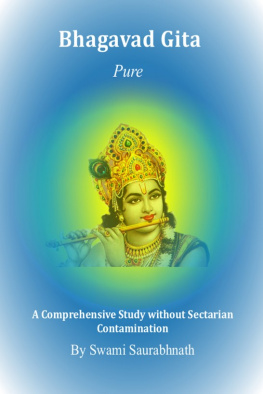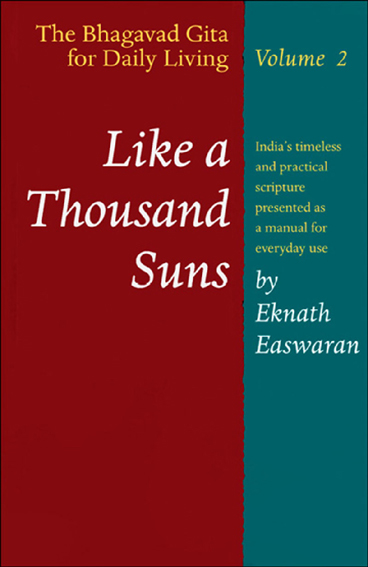INTRODUCTION
The Unity of Life
The Bhagavad Gita is the most practical of the Hindu scriptures. Some of its poetry is so magnificent that I have seldom seen its equal in any other language, but to me, the Gita is only secondarily a great work of art. Its primary value, which cuts across all barriers of time, culture, and religious background, lies in showing us how to make a work of art out of our own lives.
It is the essence of the mystical experience to enter into the depths of consciousness and discover that none of us is separate from the rest of life. All creation is part of one infinite Reality or, in more personal language, all of us are one. This is the theme of this volume, which presents the middle six chapters of the Gita. The Lord of Love, by whatever name Christ or Sri Krishna, Allah or Adonai or the Divine Mother dwells in every creature as our real Self.
In India, this realization has been part of a common spiritual heritage for thousands of years, fed by the personal experience of mystics from most of the worlds major religions. Hinduism and Buddhism, of course, originated there; Islam and Zoroastrianism have contributed to its culture for several centuries. Jewish communities in South India date from before the Christian era; and Christianity arrived in Kerala state, where I was born, long before it reached most of Europe in fact, according to Church tradition, the Gospel was brought to India by the Apostle Thomas himself in the first century A.D. Indians are used to being surrounded by many paths to God, and I dont think any people are more catholic in accepting truth in whatever religion they find it.
Against this background, there is a story about a missionary school being inspected by one of the church officials. These inspections could come at any time, and the inspector who, of course, was usually not Indian had the privilege of stepping unannounced into any classroom, playing the teacher, and asking whatever question he liked. In this story, an inspector steps in on an English class and says in English Let me ask you three questions: One, what does God know? Two, what can he do? Three, where is he to be found?
Most of the village children were taken by surprise: after all, it is hard enough to discuss theology in your own language, let alone in somebody elses. But there was one little fellow at the back who really knew his spiritual heritage. He stood up and said politely, Sir, may I ask you three questions?
The examiner was a good sport, so he said yes. And the boy asked: What does God not know? What can he not do? Where is he not?
It is a simple reply, but it says a great deal. To the mystic, it is absurd to say there is no God. He is our life, our very Self; how can we deny him? Only when we think that God is something outside us is it possible to say that God does not exist.
A few years ago I remember a columnist describing his familys trip to Europe. While they were driving through France, the children kept complaining, Dad, when are we going to see Europe? It is much like that with God. If you want to see the Lord, the mystics say, just look around you; what else is there? Open your eyes, says Hugh of St. Victor; the world is full of God.
The Sufis have a vivid image for this. The Lord, they say, is the Showman, but he is also the show. In Sanskrit he is Mahamayi, the Cosmic Magician, who has cast the illusion of separateness over all the universe. P.T. Barnum may have been proud of the greatest show on earth, but the earth itself is only a small part of the vast show that is the Lords. So the Hindu scriptures do not talk about God creating the world; they say that he became the world. It is not something different from him; it is a form which he has put on.
In our ashram, our spiritual community, we have three boys living with us who are under the age of four, and every day I have to ask them what they are. One day it is an elephant; the next, a fox or rabbit or raccoon. As one of them says, When I see an animal, I be it. He comes over in the morning and announces, Im a baby elephant! I pretend to be Uncle Elephant, twisting my trunk and wiggling my broad ears and then he suddenly says, Now Im a mouse! And everything changes; he becomes a mouse. Yet the mouse is not somebody else; it is always the same little boy.
This is how it is with the Lord. He is eternal, formless Reality, yet in his play he has put on a cosmic form, which the Buddhists call Dharmakaya: the universe itself. Galaxies, black holes, quasars, the very fabric of space and time all are part of the Cosmic Magicians display. There is nothing that exists separate from me, the Lord says in the Gita. The entire universe is suspended from me as my necklace of jewels.
In Sanskrit, the Lord as Sri Krishna is called Vistharah, he who has expanded himself much in the language of modern cosmology, which describes an expanding universe. Yet in the same breath he is called Sthavarasthanuh, he who is completely still. This is the paradox; he is both. When we look through the eyes of duality, we see a world of phenomena, of constant change matter and energy, time and death, creation and destruction. But when we look through the eye of unity as Jesus says, when our eye is single we see that all this is only surface appearance. The restlessness, the change, the duality were in our vision; beneath that appearance there is only the changeless Reality we call God.
One of the appealing implications of this is that it pulls the rug out from the disputes between religion and science. The underlying assumption in these disputes is that God and the world are separate that we are here and the Lord is out there. It is not only scientists who make this mistake; it is made in the name of religion too. Yet both science and religion are talking about the same thing, as I try to show abundantly in the chapters that follow. I have no particular interest in the philosophy behind these traditional disagreements. But it is a matter of utmost concern to all of us that scientific inquiry proceed hand in hand with spiritual awareness. Without this awareness, we are liable to violate the unity of life everywhere we go, in everything we do.
Scientific knowledge, in other words, is knowledge of separate parts of life. Spiritual knowledge wisdom is a better word is knowledge of the whole. Scientific knowledge means knowing facts; spiritual wisdom means knowing how to live. A man may be an excellent astronomer, but if he comes home in the evening and loses patience with his children, he is showing his ignorance of lifes unity. A woman may be a first-rate physician, but if she is selfish, she has not yet realized that all of us are one. Because life is whole, everything in it is interconnected; everything we do affects the rest. If we live in harmony, everything benefits a little, from our own lives through the rest of the biosphere. But if we violate the unity of existence, everything suffers our family, our society, and our own health and happiness.

